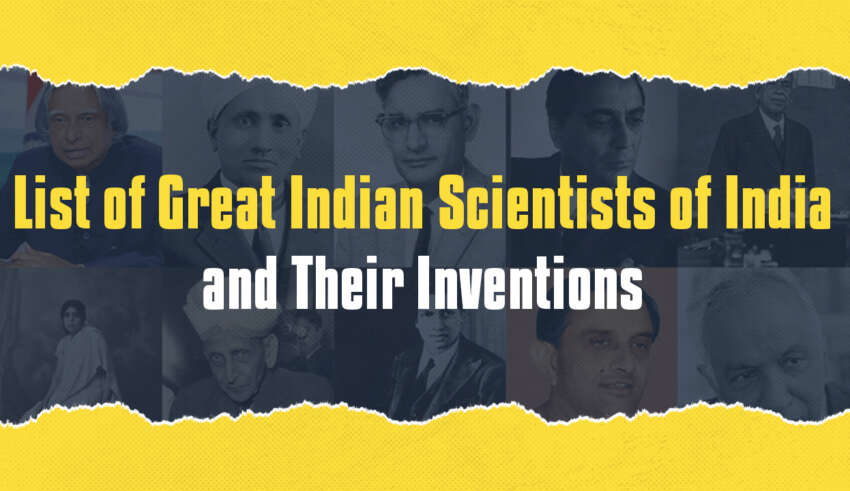
List of Great Indian Scientists of India and Their Inventions
Indian scientists play a fascinating role in our daily lives, often going unnoticed. Think about it – from our cool gadgets to the essential technologies we can’t imagine living without, everything we enjoy today is thanks to the wonders of science and technology. It makes you wonder, what would our world be like if none of these incredible inventions existed? Do we ever stop and appreciate the brilliant Indian minds behind these innovations who’ve made our lives so much easier? Well, here’s a list of 14 remarkable Indian scientists who have gained global recognition for their contributions.
Read More: List of Top 10 Most Famous Indian Mathematicians and Their Contributions
1. CV Raman
Chandrasekhara Venkata Raman, a distinguished Indian scientist, born on November 7, 1888, in Tiruchirapalli, made a significant mark in the world of science and earned the Nobel Prize for Physics in 1930. He received this prestigious honor for his groundbreaking work as an Indian scientist on the scattering of light, which revolutionized our understanding of how light behaves when it interacts with matter. Raman’s achievement was not only remarkable in itself but also historic, as he became the first Asian scientist to ever receive a Nobel Prize in the field of sciences.
In addition to his pioneering research on light, Raman, as an Indian scientist, also ventured into the field of acoustics, particularly the study of musical instruments. His inquisitive mind led him to explore the harmonic properties of traditional Indian drums such as the tabla and the mridangam. Through his work, he unveiled the intricate and melodious nature of the sound produced by these instruments, shedding new light on the science of music.
One of Raman’s most enduring legacies, as an Indian scientist, is the discovery that when light traverses a transparent substance, a portion of the scattered light undergoes a change in its wavelength. This phenomenon, now known as Raman scattering or the Raman effect, has been instrumental in a wide range of scientific applications, including the analysis of materials and the study of molecular structures.
Raman’s dedication to his work was unwavering, as evidenced by a remarkable event in his life. In October 1970, he, an Indian scientist, collapsed in his laboratory, and doctors gave him a mere four hours to live. Despite this dire prognosis, Raman, as a dedicated Indian scientist, defied the odds and not only survived but chose to leave the hospital after a few days. He decided to spend his final moments in the serene surroundings of his institute, the Raman Research Institute in Bangalore, where he cherished his beloved flowers.
Chandrasekhara Venkata Raman, a distinguished Indian scientist, eventually passed away due to natural causes on November 21, 1970. His legacy lives on not only in his groundbreaking scientific contributions but also in his heartfelt message to his students. He encouraged them not to allow the journals of the Academy to fade away, emphasizing their role as sensitive indicators of the quality of scientific work in the country and the vitality of the scientific community. Raman’s commitment to the pursuit of knowledge and his passion for science continue to inspire generations of scientists and researchers to this day.
2. Homi J. Bhabha
Homi Jehangir Bhabha, a celebrated Indian scientist, born on October 30, 1909, in Bombay, made significant contributions to the field of Quantum Theory. His remarkable career left an indelible mark on the scientific landscape of India.
One of Bhabha’s most notable achievements was becoming the first Chairman of the Atomic Energy Commission of India. His scientific journey commenced in the domain of nuclear physics in Great Britain, where he honed his expertise as an Indian scientist. Upon his return to India, he assumed a pivotal role in persuading influential figures within the Congress Party, most prominently Jawaharlal Nehru, to embark on an ambitious nuclear program for the nation, highlighting his role as an influential Indian scientist.
Bhabha is widely recognized as the visionary Indian scientist responsible for laying the foundation of Indian nuclear power. However, what’s less known is his unwavering stance against India developing atomic weapons, even if the country possessed the necessary resources. Instead, he advocated for the utilization of atomic reactors to alleviate the suffering and poverty prevalent in India, exemplifying his commitment as an Indian scientist to the betterment of society.
Tragically, the world lost this eminent Indian scientist in a fateful event. On January 24, 1966, Air India Flight 101, carrying Homi Jehangir Bhabha, crashed near Mont Blanc, resulting in the untimely demise of this prominent Indian scientist. The circumstances surrounding the crash spurred various theories, including a conspiracy hypothesis implicating the Central Intelligence Agency (CIA) in an alleged attempt to thwart India’s nuclear program, highlighting the global impact of his work as an Indian scientist.
Bhabha’s legacy endures, not only as a pioneer in nuclear science but also as a proponent of utilizing scientific advancements for the betterment of society and the alleviation of poverty, showcasing the humanitarian dimension of his work as an Indian scientist. His enduring vision continues to inspire the scientific community and underscores the importance of ethical and humanitarian considerations in the realm of scientific progress.
3. Visvesvaraya
Sir Mokshagundam Visvesvaraya, one of the great scientists of India, born on September 15, 1860, is a distinguished figure in Indian history, renowned for his multifaceted contributions as an engineer, scholar, statesman, and his role as the Diwan of Mysore from 1912 to 1918. His exceptional achievements earned him the highest honor in the Indian Republic, the Bharat Ratna, cementing his place among the great scientists of India.
A visionary thinker, Sir M. V. Visvesvaraya, one of the great scientists of India, emphasized that India should strive to achieve parity with industrialized nations, firmly believing that industrialization was the path to India’s development and prosperity. His vision as one of the great scientists of India laid the foundation for India’s progress.
Among his many accomplishments, Visvesvaraya’s innovative creations, as one of the great scientists of India, stand out. He is credited with the invention of ‘automatic sluice gates’ and the ‘block irrigation system,’ engineering marvels that continue to be highly regarded in their fields. These contributions, among those of the great scientists of India, have had a lasting impact on water management and irrigation practices.
Sir M. V. Visvesvaraya’s legacy extends to the annual celebration of Engineer’s Day in India, held on his birthday, September 15. This day serves as a tribute to his remarkable achievements and the enduring influence of his work, a tradition established by the great scientists of India.
One of his pioneering solutions, developed in 1895, involved the efficient filtration of water through ‘Collector Wells,’ a groundbreaking technique developed by one of the great scientists of India. This not only addressed the issue of costly riverbed filtration but was also a rare innovation seen anywhere in the world. His dedication to finding practical solutions to real-world problems has left an indelible mark on the field of engineering, contributing to his legacy among the great scientists of India.
In summary, Sir Mokshagundam Visvesvaraya’s life and work, as one of the great scientists of India, epitomize the spirit of innovation and commitment to progress. His contributions, like those of other great scientists of India, continue to inspire engineers and scientists, and his legacy is celebrated annually on Engineer’s Day in India.
4. Venkatraman Radhakrishnan
Venkatraman Radhakrishnan, one of the famous Indian scientists, born on May 18, 1929, in Tondaripet, a suburb of Chennai, was a revered figure in the field of space science. Notably, he held membership in the prestigious Royal Swedish Academy of Sciences, a testament to his international recognition and influence as one of the famous Indian scientists.
Radhakrishnan’s reputation, like that of other famous Indian scientists, extended far beyond his contributions as an astrophysicist. He was a polymath, known for his ingenuity in designing and building ultralight aircraft and sailboats, showcasing his versatile talents and interests, a characteristic shared with other famous Indian scientists.
His scientific endeavors, like those of other famous Indian scientists, made a profound impact on our understanding of the cosmos. Through his observations and theoretical insights, he played a crucial role in unraveling numerous enigmas related to pulsars, interstellar clouds, galaxy structures, and a multitude of celestial bodies. His work expanded our knowledge of the universe and contributed significantly to the field of astrophysics, a contribution shared by other famous Indian scientists.
Tragically, this eminent Indian scientist, among the famous Indian scientists, passed away at the age of 81 in Bangalore. Venkatraman Radhakrishnan’s legacy, like that of other famous Indian scientists, lives on as a symbol of scientific excellence and his invaluable contributions to the exploration of the universe. His work, like that of other famous Indian scientists, continues to inspire future generations of scientists and researchers in the field of astrophysics.
5. S. Chandrashekar
Subrahmanyan Chandrasekhar, an eminent Indian scientist known by his name, is one of the famous Indian scientists, born on October 19, 1910, in Lahore, British India. He is an eminent figure in the world of physics. He gained widespread recognition when he was awarded the Nobel Prize for Physics in 1983, an honor bestowed upon him for his groundbreaking mathematical theory related to black holes, as acknowledged by Subrahmanyan Chandrasekhar’s name. His significant contributions led to the creation of the “Chandrasekhar limit,” a concept named in his honor, emphasizing the impact of Subrahmanyan Chandrasekhar’s name on the field of astrophysics.
Notably, Subrahmanyan Chandrasekhar had a familial connection to another notable scientist, C. V. Raman, as he was Raman’s nephew, further highlighting the scientific legacy associated with Subrahmanyan Chandrasekhar’s name.
Chandrasekhar’s most celebrated and influential work revolved around the radiation of energy from stars, with a particular focus on white dwarf stars, as recognized by Subrahmanyan Chandrasekhar’s name. These celestial bodies represent the remnants of stars in their final stages of life. His research in this area contributed significantly to our understanding of how stars evolve and release energy, a legacy marked by Subrahmanyan Chandrasekhar’s name.
Tragically, this brilliant physicist passed away on August 21, 1995, at the age of 82 in Chicago, marking the end of a remarkable career and a lifetime of scientific achievements, underlining the significance of Subrahmanyan Chandrasekhar’s name. Subrahmanyan Chandrasekhar’s work has left an enduring legacy in the field of astrophysics and continues to inspire scientists and researchers worldwide, preserving the memory of Subrahmanyan Chandrasekhar’s name.
6. Satyendra Nath Bose
Born on January 1, 1894, in Calcutta, Satyendra Nath Bose was a distinguished Indian physicist who specialized in the field of quantum mechanics. His most enduring legacy is associated with the class of particles known as “bosons,” a term coined in his honor by the renowned physicist Paul Dirac, recognizing Bose’s significant contributions to this domain.
Bose’s remarkable journey into the world of physics began when he adapted a lecture he delivered at the University of Dhaka on the theory of radiation and the “ultraviolet catastrophe” into a concise article titled “Planck’s Law and the Hypothesis of Light Quanta.” This article was sent to none other than Albert Einstein, a giant in the field of physics. Einstein, after reviewing Bose’s work, found merit in it and proceeded to translate the article into German. The translated work, “Planck’s Law and Hypothesis of Light Quanta,” was then published in Zeitschrift für Physik, with Bose’s name attached to it, in 1924. This groundbreaking collaboration between Bose and Einstein laid the foundation for what would become known as Bose-Einstein Statistics, a fundamental concept in the realm of quantum mechanics.
The significance of Bose’s contributions extended beyond the world of science. In 1937, the illustrious poet and philosopher Rabindranath Tagore dedicated his only book on science, “Visva–Parichay,” to Satyendra Nath Bose, acknowledging the profound impact of Bose’s work. Additionally, the Government of India recognized his exceptional achievements by bestowing upon him the Padma Vibhushan, India’s second-highest civilian award, in 1954.
Satyendra Nath Bose’s scientific and intellectual pursuits continue to inspire both the scientific community and the nation. His contributions to quantum mechanics, immortalized in the term “bosons,” remain a vital part of our understanding of the subatomic world, and his work serves as a source of pride for India and the world of physics.
7. Meghnad Saha
Meghnad Saha, born on October 6, 1893, in Dhaka, Bangladesh, made enduring contributions to the fields of astrophysics and river planning in India, leaving a significant mark on both scientific and infrastructure development.
Saha’s most renowned work centered around the thermal ionization of chemical elements, and his research culminated in the formulation of what is now called the “Saha Equation.” This equation holds a pivotal role in astrophysics, serving as a fundamental tool for interpreting the spectra of stars. By analyzing the spectral lines emitted by stars, scientists can deduce vital information, such as the star’s temperature. Utilizing Saha’s equation, they can further determine the ionization state of the various chemical elements composing the star. This profound insight revolutionized our ability to study and comprehend the properties of celestial bodies.
Beyond his contributions to astrophysics, Saha demonstrated his innovative spirit by inventing an instrument capable of measuring the weight and pressure of solar rays, expanding our capacity to study and harness solar energy.
However, Saha’s talents extended far beyond the realms of astrophysics and solar research. He played a pivotal role in shaping the development of India’s infrastructure as the chief architect of river planning in the country. In this capacity, he meticulously crafted the original plan for the Damodar Valley Project, a significant initiative aimed at harnessing the region’s water resources for irrigation, flood control, and power generation.
Meghnad Saha’s legacy remains a testament to the power of scientific inquiry and visionary thinking. His Saha Equation continues to be an indispensable tool in astrophysics, enabling scientists to unlock the secrets of the stars. Furthermore, his contributions to solar research and his pivotal role in river planning demonstrate his diverse talents and the profound impact he had on India’s scientific and infrastructure development.
8. Srinivasa Ramanujan
Born on December 22, 1887, in Tamil Nadu, Srinivasa Ramanujan was an extraordinary Indian mathematician and autodidact who, despite minimal formal training in pure mathematics, left an indelible mark on the fields of mathematical analysis, number theory, infinite series, and continued fractions.
Ramanujan’s early aptitude for mathematics was nothing short of exceptional. By the age of 11, he had already surpassed the mathematical knowledge of two college students who resided in his home as lodgers. His intellectual hunger and passion for math were remarkable.
A pivotal moment in Ramanujan’s journey came when he was lent a book on advanced trigonometry authored by S. L. Loney. Astonishingly, he not only devoured the content but also embarked on a journey of self-discovery, formulating sophisticated theorems independently, all before the age of 13. This early display of genius was a harbinger of the groundbreaking work he would later contribute to the field of mathematics.
Ramanujan’s life was not without challenges. While living in England, he faced significant health problems, exacerbated by the scarcity of vegetarian food options that suited his dietary restrictions. Eventually, his health deteriorated, compelling him to return to India. Tragically, Ramanujan’s life was cut short, and he passed away at the tender age of 32.
Today, Ramanujan’s home state of Tamil Nadu celebrates December 22, Ramanujan’s birthday, as ‘State IT Day.’ This commemoration not only honors the man himself but also serves as a tribute to his incredible achievements and the enduring impact of his work. Srinivasa Ramanujan’s legacy stands as a testament to the limitless potential of human intellect and the transformative power of mathematics.
9. Jagadish Chandra Bose
Acharya Jagadish Chandra Bose, born on November 30, 1858, in Bikrampur, West Bengal, was a true polymath, excelling in numerous fields including physics, biology, botany, and archaeology. His remarkable contributions spanned a wide spectrum of disciplines and significantly impacted the development of science in the Indian subcontinent.
One of Bose’s pioneering achievements was in the realm of radio and microwave optics. He laid the foundation for the study of these subjects and was notably the first individual to utilize semiconductor junctions for the detection of radio signals. This groundbreaking work marked the inception of wireless communication, a technology that would later revolutionize the world. What’s particularly remarkable about Bose is his open approach to technology and innovation. He freely shared his inventions and research, choosing not to patent his work. His commitment to the open exchange of knowledge set an inspiring precedent.
Among his inventions, the crescograph stands out. This ingenious device enabled Bose to measure the responses of plants to various stimuli, leading to the hypothesis that plants could experience sensations such as pain and respond to affection. His pioneering work in this area was instrumental in shaping our understanding of plant biology.
While Acharya J.C. Bose is primarily celebrated for his scientific achievements, he also made a noteworthy foray into the world of literature, particularly as an early writer of science fiction. He is often recognized as the father of Bengali science fiction, showcasing the depth and diversity of his intellectual talents.
Acharya Jagadish Chandra Bose’s multifaceted contributions have left an enduring legacy, both in the scientific realm and in the broader cultural and literary landscape. His open and collaborative approach to science and his pioneering work continue to inspire scientists, researchers, and creators alike.
10. Vikram Sarabhai
Vikram Sarabhai, born on August 12, 1919, in Ahmedabad, Gujarat, is rightfully hailed as the “Father of India’s space program.” His visionary leadership and unwavering commitment to scientific progress have left an indelible mark on India’s scientific landscape.
Sarabhai’s pivotal contribution came with the establishment of the Indian Space Research Organization (ISRO). At a time (race against time phrase meaning) when the world was witnessing the launch of the Russian Sputnik, he successfully convinced the Indian government of the significance of a space program for a developing nation. In his famous statement, he articulated the purpose of India’s space endeavors, emphasizing that the nation did not aim to compete with advanced countries in exploring celestial bodies but rather to harness advanced technologies for addressing real societal challenges. This vision underscored the pragmatic and utilitarian nature of India’s space program.
Sarabhai’s contributions were not limited to space exploration alone. He received the Padma Bhushan in 1966 and the Padma Vibhushan posthumously in 1972, recognizing his exceptional service to the nation. While he is widely acknowledged for his pivotal role in founding ISRO, his influence extended beyond the realm of space research. He played a crucial role in establishing other renowned Indian institutions, most notably the Indian Institute of Management, Ahmedabad (IIM-A), and the Nehru Foundation for Development.
Vikram Sarabhai’s legacy is marked by his foresight, dedication, and the profound impact of his vision on India’s scientific and educational landscape. His pioneering spirit continues to inspire generations of scientists, scholars, and leaders, both in India and around the world.
11. Salim Ali
Salim Moizuddin Abdul Ali, born on November 12, 1896, in Mumbai, was a distinguished ornithologist and a devoted naturalist. His lifelong passion for birds and nature would ultimately make him a significant figure in the world of Indian ornithology.
Salim Ali can be aptly called the “Birdman of India” for his pioneering work in systematically surveying the avian species across the vast landscape of India. His comprehensive bird books served as crucial resources in advancing the study of ornithology in the Indian subcontinent. Through his meticulous surveys and publications, he not only enriched our understanding of Indian birds but also inspired countless individuals to delve into the field of ornithology.
Beyond his scientific contributions, Salim Ali played a pivotal role in shaping the Bombay Natural History Society (BNHS) after India gained independence in 1947. His personal influence and advocacy were instrumental in securing government support for the organization. Under his leadership, the BNHS continued to thrive and contribute significantly to the conservation and study of India’s rich biodiversity.
In recognition of his exceptional contributions to the field of ornithology and his unwavering dedication to the natural world, Salim Ali received India’s second-highest civilian honor, the Padma Vibhushan, in 1976. His legacy endures as an inspiration to both scientists and conservationists, reminding us of the importance of understanding and preserving the rich birdlife and natural heritage of India. Salim Ali’s life and work remain a testament to the power of passion and dedication in advancing the fields of science and conservation.
12. Har Gobind Khorana
Har Gobind Khorana, born on January 9, 1922, in Raipur village, West Punjab (now in Pakistan), was a prominent Indian-American biochemist whose groundbreaking research led to significant advancements in our understanding of genetics and the synthesis of artificial genes. His work not only earned him the 1968 Nobel Prize for Physiology or Medicine but also laid the foundation for critical developments in biotechnology and gene therapy.
Khorana’s Nobel Prize-winning research, which he shared with Marshall W. Nirenberg and Robert W. Holley, delved into the role of nucleic acids in controlling the synthesis of proteins within a cell. His work clarified how the sequence of nucleotides in nucleic acids, which contain the genetic code of a cell, influences the process of protein synthesis. This discovery was a major breakthrough in the field of molecular biology, deepening our comprehension of the fundamental mechanisms governing life.
In 1970, Khorana achieved another remarkable milestone by becoming the first scientist to successfully synthesize an artificial gene within a living cell. This achievement revolutionized biotechnology and gene therapy, opening up new avenues for the development of treatments and technologies that have since transformed the field of genetics.
Few people are aware that in 2007, the University of Wisconsin-Madison, the Government of India (Department of Biotechnology), and the Indo-US Science and Technology Forum jointly established the Khorana Program. This program is dedicated to fostering collaboration between scientists, industrialists, and social entrepreneurs in the United States and India, with the aim of advancing scientific research and innovation.
Tragically, Har Gobind Khorana passed away from natural causes on November 9, 2011, at the age of 89. His enduring legacy as a pioneering biochemist continues to influence and inspire scientific advancements in genetics, biotechnology, and beyond.
13. Birbal Sahni
Birbal Sahni, born on November 14, 1891, in West Punjab, was a renowned Indian paleobotanist whose multifaceted interests extended to geology and archaeology. His lasting legacy is firmly rooted in his comprehensive exploration of the plant life of India, both in its contemporary context and its historical dimension.
Birbal Sahni’s remarkable achievements were widely recognized, and in 1936, he earned one of the most esteemed honors in British science, being elected a Fellow of the Royal Society of London (FRS). His election marked a historic moment as he became the first Indian botanist to receive this prestigious distinction, highlighting the international recognition of his work.
Sahni’s dedication to paleobotany led to the founding of The Paleobotanical Society. This society played a pivotal role in establishing the Institute of Palaeobotany on September 10, 1946. Initially, the institute operated within the Botany Department of Lucknow University. The institute would go on to become a renowned center for paleobotanical research and a testament to Sahni’s vision and commitment to advancing this field.
Tragically, the scientific community lost this eminent Indian scientist on April 10, 1949, when he suffered a heart attack. His contributions to the study of ancient plant life and his role in founding critical institutions continue to shape our understanding of botany, paleobotany, and the scientific heritage of India. Birbal Sahni’s legacy lives on, inspiring future generations of scientists and researchers.
14. APJ Abdul Kalam
Avul Pakir Jainulabdeen Abdul Kalam, born on October 15, 1931, is a renowned Indian scientist who made significant contributions as an aerospace engineer within two of India’s premier research organizations: the Defence Research and Development Organisation (DRDO) and the Indian Space Research Organisation (ISRO).
Kalam’s illustrious career began with the design of a small helicopter tailored for the Indian Army, reflecting his early foray into aerospace engineering. His association with the INCOSPAR committee, led by the celebrated space scientist Vikram Sarabhai, marked the start of his involvement in India’s space program. In 1969, Kalam transitioned to ISRO and assumed the role of project director for India’s first indigenous Satellite Launch Vehicle (SLV-III). Under his leadership, this project culminated in the successful deployment of the Rohini satellite into near-Earth orbit in July 1980, a significant milestone in India’s space exploration endeavors.
Apart from his pioneering contributions to science and technology, Kalam also served as the 11th President of India, holding the office from 2002 to 2007. He was a visionary leader who advocated ambitious plans for India’s progress, as detailed in his book “India 2020.” His vision aimed to transform India into a developed nation by the year 2020, emphasizing the country’s development across various sectors.
Kalam’s outstanding achievements earned him numerous prestigious awards, including the Bharat Ratna, India’s highest civilian honor, in recognition of his exceptional contributions to the nation. Beyond his scientific and political roles, Kalam was widely admired for his affection for children and his dedication to education. After stepping down from the position of scientific adviser in 1999, he set a remarkable goal of personally meeting 100,000 students within two years, reflecting his passion for inspiring and nurturing young minds.
Dr. A.P.J. Abdul Kalam’s enduring legacy continues to serve as a beacon of inspiration to millions, reflecting his dedication to science, education, and the betterment of India’s future.
In this exploration of the groundbreaking contributions by some of the famous scientists of India, we have delved into the remarkable work of these renowned individuals who have left an indelible mark in the world of science. From their pioneering inventions to their profound theories, these famous scientists in India have significantly advanced our understanding of various fields. As we celebrate the legacy of these famous scientists in India, their remarkable achievements serve as a testament to the rich tradition of scientific excellence in the country. Through the exemplary work of these famous scientists of India, they have not only enriched our knowledge but have also inspired future generations to continue pushing the boundaries of scientific discovery. This list of great Indian scientists and their inventions showcases the invaluable contributions of these remarkable individuals and their enduring impact on the world of science.













